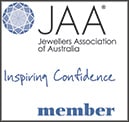
Diamond 4 - C's The Easy Version
Buying a Diamond should be a wonderful experience – make sure your decision is informed, and understand the dangerous limitations of the 4Cs!
Our Jewellers, lapidarist, gemmologist, diamond grader and Sales staff has extensive qualified knowledge about diamonds, and are happy to spend time with you explaining the 4Cs and more importantly beyond due to the 4C’s serious gaps, problems and pitfalls.
Ringleaders have all white diamonds, from D colour diamonds to H colours.
Carat.
Carat is the unit of the weight of a diamond or gGem only. One carat is one-fifth of a gram and is expressed 1.00ct. A half carat diamond would be expressed .50ct.
If a cut perfectly, depth has to increase proportionally with width. This adds a more and more weight for a smaller and smaller increases in the width (i.e. 0.50ct weight = 5.1mm diameter, 1.00ct weight = 6.45mm diameter, weight Up 100%, diameter Up only 26%).
Cut.
Cut refers to three aspects.
The first aspect would be the shape of the stone if you were to look at it from the top. Today, there are several different shapes such as including Round, Emerald, Baguette, Cushion, Square Cushion, Asscher, Carre, Pear, Oval, Marquise, Radiant, Square Radiant, Heart, Princess cut and some more of the least common cuts.
The second is some of these shapes that can be cut in different ways (i.e. brilliant, step, scissor, etc.). Some of these styles will display much more brilliance, and it is all down to personal taste.
However, today, with the lie that more facets = brighter, this is used to seem better.
Due to the size of diamonds and gems, more facets = Smaller facets = Less impact on the eye. Compare a 1ct Princess to a 1ct Brilliant cut Diamond, 90% of people say the brilliant looks brighter.
The third aspect is the quality of the cut, i.e. the amount of light refracted back towards you. Sadly, as our lapidarist who spent five years (importantly non-commercially) learning how to cut correctly. Attaining the highest price for all diamond and gems, unfortunately, is the most important and the cut is the first sacrifice. As such, all cut, and grading systems are based on lies and gimmicks (with new ones being invented all the time) to suit the industry.
But with 38 years’ experience, our lapidarist can explain the real story of cut, as he says this is the first of the two most important visual qualities.
Please Note-
Special lights (rotating, special multi colours, etc.) are used in stores or picture to make diamonds or gems sparkle more and to look brighter.
Special programs are used (photosimilie, 3D photomation, etc) to remove and/or hide inclusions online or in videos. Some use “File photo’s i.e. photos of other diamonds)
Never look at diamonds under the sun, only use bright diffused lighting when choosing a gem.
Colour.
The second of the two most important visual qualities.
For white diamonds or coloured diamonds, colour is one of the most visually apparent characteristics to consider before you purchase. The quality of white diamonds is measured against a scale which uses a letter to express the different grades.

The white diamond scale starts at D, the optimum grade, and continues alphabetically towards Z as the colour becomes progressively tainted. Ringleaders specialise in using D, E, F, G and H, as these grades are the only grades classed as white.
Please Note-
“Low” H colours can look tainted next to F or above.
Many fake online jewellers even show I, J and even K colours as colourless.
Special lights (i.e. blue, etc.) are used in stores or pictures to cancel out colours and/or make these sparkle more or even look brighter.
Never look at Diamonds under the sun, only diffused lights when choosing.
For coloured diamonds, a secondary or tertiary colour usually vastly devalues the diamond. Each colour has its grading scale, and generally the darker and most pure colours have the highest rarity and value.
Clarity.
As the word suggests, the clarity of a diamond refers to its clearness: the fewer anomalies, or inclusions, the better the clarity. Clarity is measured against a scale: the optimum being graded as Flawless or Fl, and the lowest is graded as Included 3 or I 3.
Inclusion refers to any anomaly present either inside the diamond or anywhere on its external surface.
Flawless refers to a diamond that has no visible inclusions when viewed under a ten x power magnifying lens.
Clarity is the most dangerous of all the 4C’s as the most common inclusion left in cut diamonds can easily chip, crack or even split a stone in half (ironically this property is the only reason why diamonds can be cut and polished as there is nothing harder than diamonds to cut them with).
All diamonds that Ringleaders sell are individually scrutinized by us to ensure they have been graded accurately, (often claimed but rarely ever done), and also reject any with insidious and/or dangerously inclusions as we are the only jewellers with staff with full qualifications in 4 different areas.
Graders are very limited by the 4C’s grading process, which besides the many oversights, allows cutting to exploit these limitations to achieve high grading for very dangerous or insidious inclusions.
Ringleaders do not sell conflict Diamonds.

